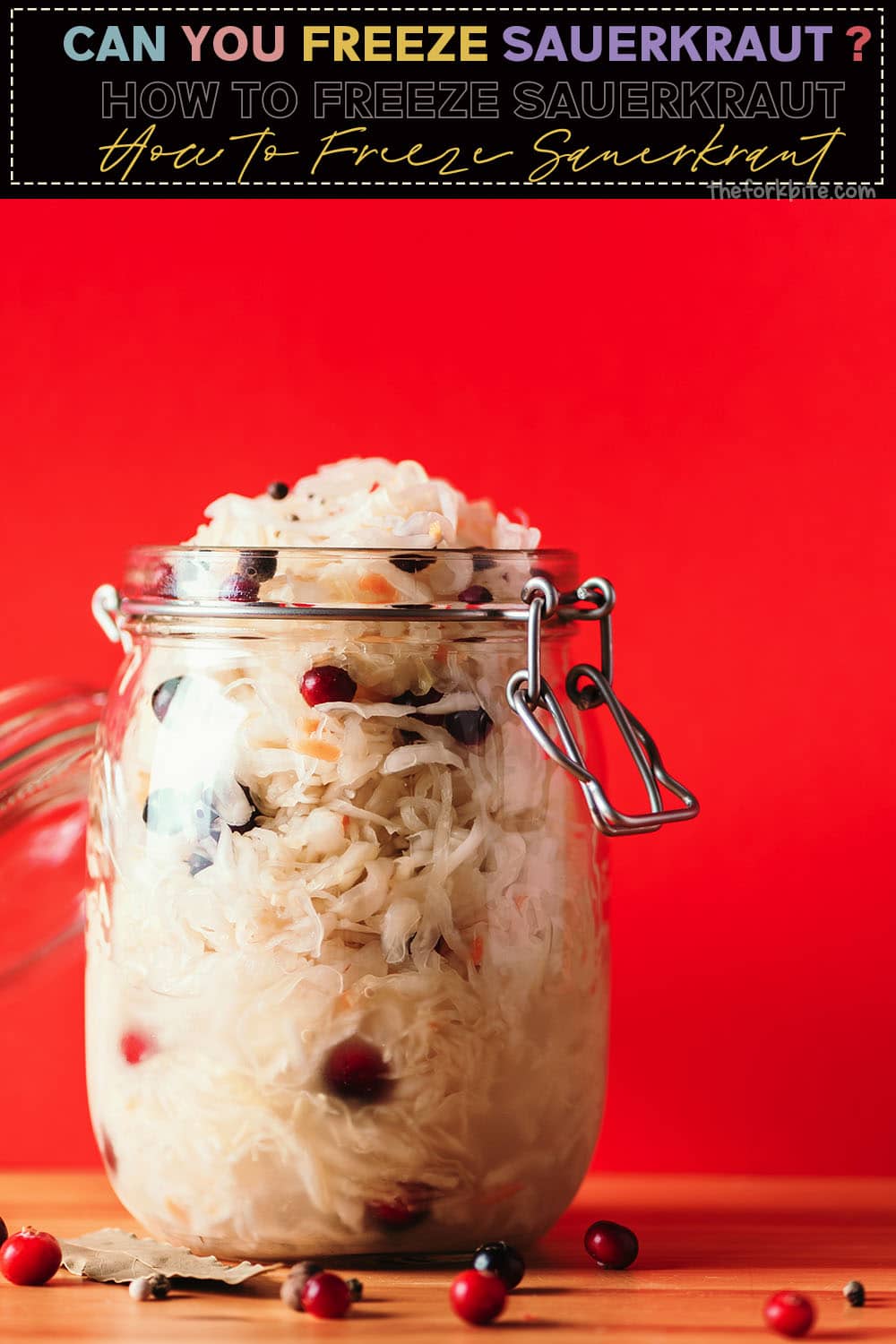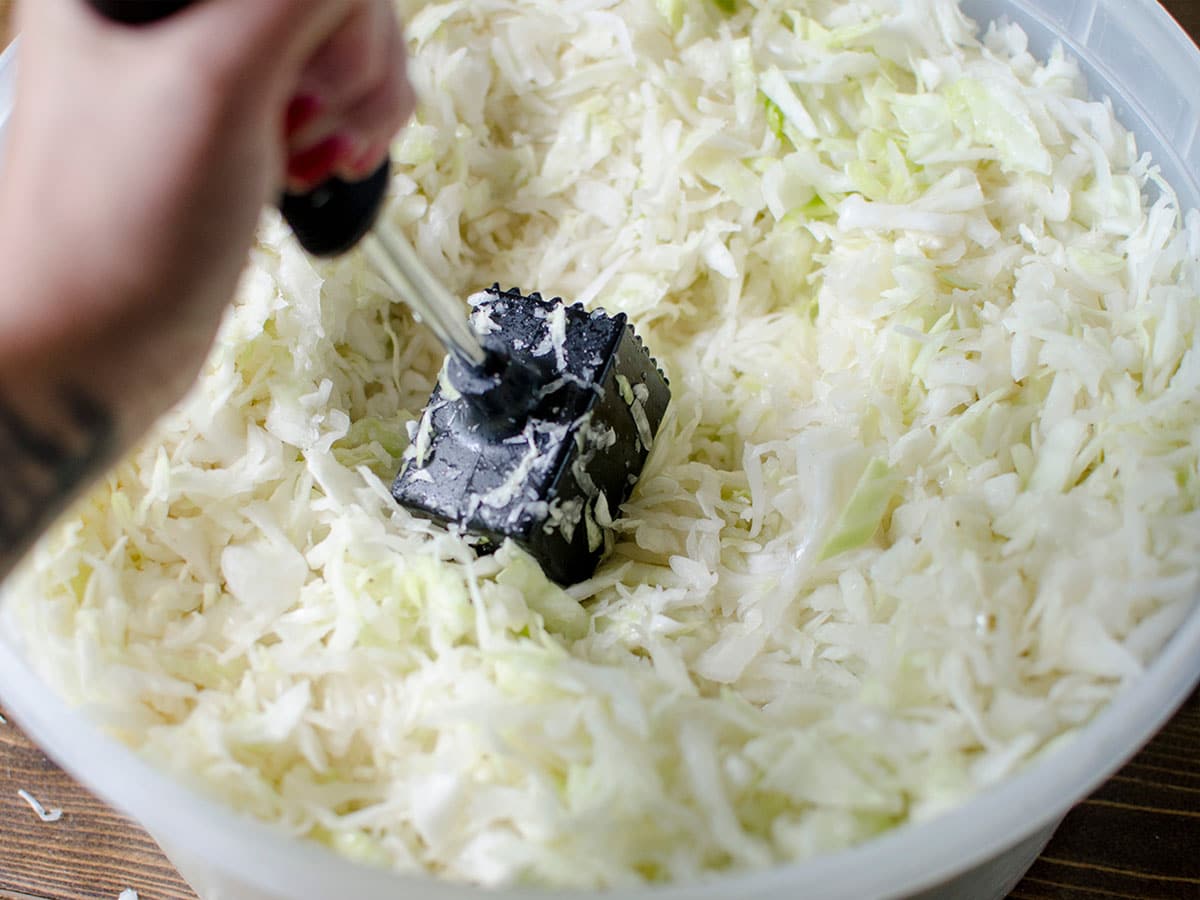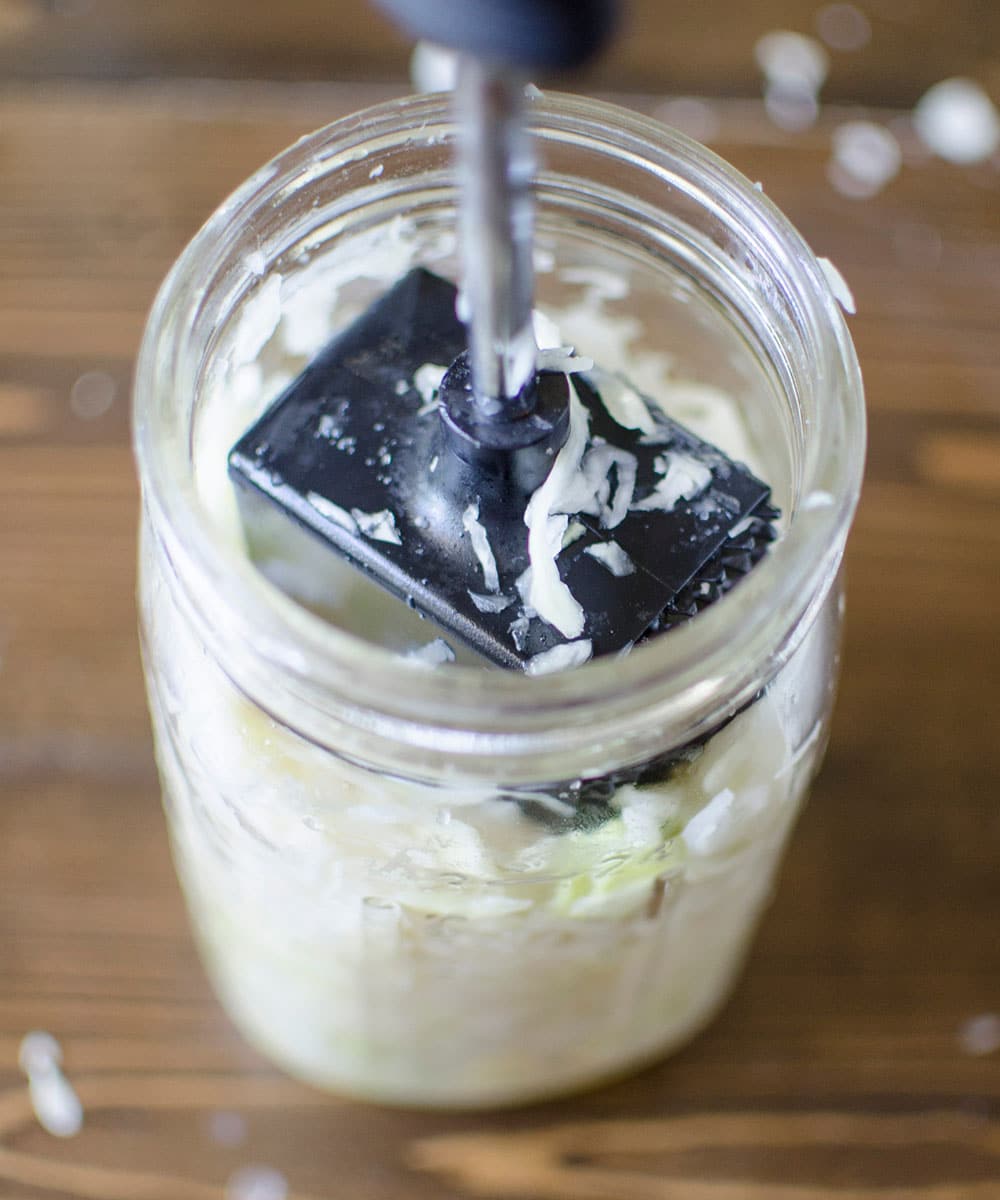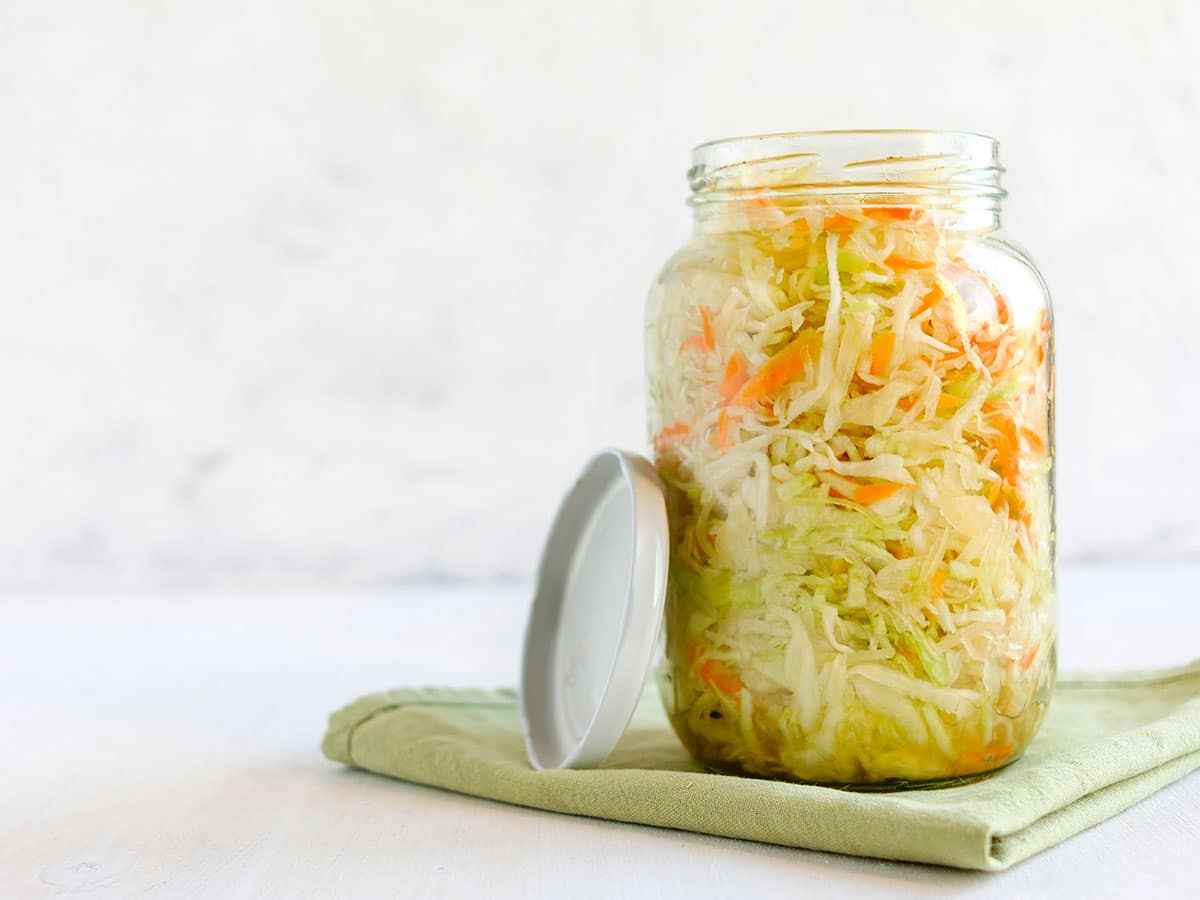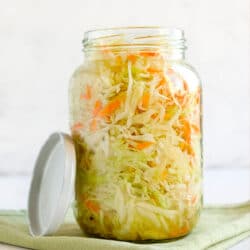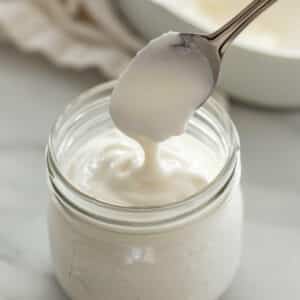In short, yes, you can freeze sauerkraut. If you wish for the authentic cabbage dish to retain its robust flavor, it is essential that you only freeze them FRESH.
When dealing with foods, you must learn the proper storage methods and the techniques used to store foods successfully. Have you ever discovered beans from the last meal in the refrigerator covered with a web-like mold?
What about condiments – such as jam – that has turned into a liquid-like slime? Or, a tub of sour cream that has unusually bright moldy marks on its surface, marked by a pungent smell?
Jump to:
If you answered "yes" to any of these questions, you have likely wondered exactly how food manufacturers ensure that their products have a long shelf life.
It is no different than to wonder how YOU can increase your food products' real sauerkraut. It is all in the methodology and the technique.
Continue reading to learn more.
What is Sauerkraut?
"Sauerkraut" – going bad the word alone, this does not sound like a very delectable dish; however, it is! This is a type of fermented cabbage. It is believed to have officially originated in China several thousand years ago but is most closely associated with cuisine with Polish or even German backgrounds.
According to food health professionals, it is a food product that does – naturally -have an extensive shelf-life; however, it is possible to increase shelf life. You will want to when it comes to sauerkraut because this food product is said to benefit your health in numerous ways!
Throughout history, many cultures have attempted to store this dish. Those who resided in the northern regions of Russia and of Siberia were the ones that experienced the highest level of success. These areas were known for their low temperatures and the vast amount of snow that they regularly received.
These people would take huge wood-based barrels, clean them, and place the sauerkraut in them. They were then close the barrels and leave them outside in the extreme cold. They always had a batch of the frozen and the fermented cabbage available for consumption and loved having a large helping!
Today, many people consume this strong-tasting cabbage dish regularly. It is still frozen – only instead of barrels, it is placed in specially-designed bags for the freezer or containers that may be placed safely in the freezer. If you find yourself with a huge amount of sauerkraut that just cannot be consumed quickly, store and freeze it for safekeeping so that it may – again - be enjoyed.
Is There a "Best" Way to Freeze Sauerkraut?
If you have asked the question, "Can you freeze sauerkraut?" it is quite likely that you wonder if there is an optimal method for freezing the cabbage dish. The good news is, there is an optimal way to store sauerkraut when freezing:
- Place sauerkraut in a Ziplock bag or any container appropriate for freezing, and leave 2 inches of space at the top. When the sauerkraut freezes, it will expand, taking up additional room in the freezer.
- If using a freezer bag, be sure that you squeeze out additional air before you seal it.
To prevent the development of freezer burn, you may layer the freezer bags that you use. Many will triple-layered them for added protection. - If you use a freezer bag, lay it flat down and put the date and content information on it once you have sealed it. When placed in the freezer, be sure to lay it flat down not to take up a lot of space.
- It is best to freeze in a deep freezer. This is because sauerkraut freezes best at 0°F or less.
Once you are ready to use the sauerkraut, defrost it in the refrigerator. - You may store your sauerkraut safely for anywhere from 8 months to 12 months.
Step 1: Portion Size Selection
You must pay close attention to the portion size when freezing sauerkraut. Smaller portions freeze at a much faster rate, but it helps plan meals. Before freezing, determine an appropriate portion size for your family and freeze based on that.
Step 2: Container Selection
If freezing in a way that will allow you to thaw quickly, you should place the sauerkraut in a freezer-safe container. Then, you will be able to take out the container, run it under cold water, and the sauerkraut will easily pop right out.
If you are searching for a way to freeze and save space, you should use freezer bags. You may place enough in the bag to fill ¾ of it. Be sure to squeeze out the air and lie flat and stack once in the freezer.
Step 3: Avoiding Freezer Burn
Freezer burns are common when freezing certain types of foods. The good news is, this can be avoided when freezing your sauerkraut. This is caused by exposure to air and the development of ice crystals. Simply take the steps that will help to keep air from coming in contact with the sauerkraut.
Liquid expands when it is subjected to frozen temperatures. You should strive to ensure that you provide ample space for this expansion when the sauerkraut freezes. Never overfill, or freezer burn will occur, and the bag or container you have it in is more likely to rip or crack. If this happens, the sauerkraut must be discarded.
Only fill approximately ¾ of the bag or container that you use. Additionally, always push out all of the air. If you are using freezer storage bags, be sure to triple-layer them to ensure a higher level of protection for the fermented cabbage.
Step 4: Labeling is Critical
As with any food, if you freeze sauerkraut, you must label and date the container and/or bag you place it in before locating it in the freezer.
How to defrost
Once you reach the point where you are ready to prepare the sauerkraut for consumption, you should place the frozen version in your refrigerator for at least 24 hours. Once thawed, it should be consumed as quickly as possible.
- If you want to defrost quickly, place the sauerkraut in the microwave, and utilize the defrost option. If there is no such feature, reduce the appliance's power to 30% or 50% and run for one-minute intervals until the food is completely thawed. Be certain to stir after each minute until the dish is ready.
- Many elect to thaw their sauerkraut on the kitchen counter. You may do this, but only for 2-3 hours at a time. Once thawed, either place in the refrigerator or consume. If you place it in the fridge or have any leftovers, they may be placed back in the refrigerator for 3-5 days. After this, immediately discard.
- You will find that the texture of the sauerkraut changes a bit after being frozen. This is because of the water molecules. You will find that it is much softer after being thawed. This is acceptable and is safe to eat.
How long will the Sauerkraut last in the freezer?
In terms of quality, sauerkraut will last anywhere from 8 to 12 months once placed within the freezer. If you find that it is mushy, looks bad, or has an odor, throw it out.
Freezing can kill Probiotics?
While it is difficult to discover the answer to this particular question, other food products -such as kefir grains and Kombucha SCOBY – maintain their probiotic content when frozen. It is believed that a large portion of the probiotics will survive freezing; however, a small amount of the probiotics will likely die off when introduced to freezing temperatures.
Will freezing can destroy the taste and texture?
In most instances, sauerkraut will maintain both its taste and its overall texture when frozen. The way it is stored, the temperature settings, and its length in the freezer could directly impact taste and texture. While we are on the topic, consider reading resources on the signs of fermented foods going bad.
Benefits of eating Sauerkraut
Nutritional Advantages
Sauerkraut is a food known to be high in Vitamin B6, Vitamin C, Vitamin K and a good source of folate. Additionally. It contains many levels of phosphorus, calcium, iron, magnesium, and potassium. All of these substances are enhanced by fermenting that is required to create sauerkraut. As a bonus, most are retained at high levels when the product is heated and frozen. A cup of sauerkraut contains 19 micrograms (vitamin K), which is about 20% of our daily needs.
Probiotics
Probiotics are types of live bacteria that are contained within the gastrointestinal tract. These are highly beneficial to your overall health. (study)
This help boosts your immune system, aid in the health of your heart, reduce the severity of certain conditions – such as eczema and allergies -and keep bad bacteria at bay. There are high levels of lactobacilli that aid in digestion and aid in absorbing minerals and vitamins.
The health benefits of providing nutrition to the organisms in the digestive system:
-
Improved Digestion
By eating sauerkraut, you provide nutrition to all of the good bacteria present in your digestive system. This will – in turn -optimize the overall health of your digestive system.
-
Immune System Stimulation
The digestive system makes up the largest amount of your immune system. It is estimated at least 70%! By eating sauerkraut, you are stimulating the immune system, and your body will be better able to ward off illnesses, diseases, and other types of infectious agents.
-
Reduced Inflammation
Probiotics aid in the multiplication and regulation of certain cells that directly control inflammation levels within the body. These also help in combatting infections, allergic reactions, and the overall health of your skin.
-
Cognitive Health Boost
It has been said, "Happy Belly Makes for Happy Brain." By consuming sauerkraut, you will find that you experience fewer bouts of nervousness, brain fog, and mental health issues. Instead, you will discover great focus, concentration, and that you maintain a fantastic mood.
-
Antioxidants That Fight Cancer
Cabbage is a food product that is known to contain a very high level of antioxidants. These produce special types of enzymes capable of fighting damage within the body caused by free radicals. This increases your health and reduces your risk of developing cancer.
Enzymes
These particular substances are a natural component of both raw and fresh foods. They are critical to the metabolism-based and digestive-based functions of your body.
Sauerkraut contains these substances; however, it must be noted that temperatures of 118°F will destroy these enzymes.
Antioxidants
There are many antioxidants contained in sauerkraut, such as glucosinolates and ascorbigen. These aid in combatting cancer; however, it should be known that canning this food product will destroy these special substances. If fighting cancer, sauerkraut should be raw to offer the highest level of benefits.
This is because raw contains the highest level of lactic acid and probiotics. Cooking or pasteurizing the sauerkraut will result in immediate damage to the properties that aid in cancer prevention.
Fiber
Whether it is raw or fermented, cabbage is a widely popular vegetable for the vast levels of fiber it contains. This helps the digestive system perform optimally. It does not matter if sauerkraut made from cabbage is cold or hot; fiber is retained.
Lactic Acid
Due to the lactobacilli present in the sauerkraut, the fermentation process creates lactic acid. This helps preserve your sauerkraut, prevents the growth of unhealthy bacteria, and provides that unique taste that we all love in sauerkraut. It also helps ensure that our digestive tracts are performing optimally. It appears lactic acid is not negatively impacted by heat.
5 ways of storing Sauerkraut
#1. Increasing Shelf Life Through Canning
In our nation's history – like during the Great Depression – foods were canned so that families could properly sustain themselves throughout long periods, such as the winter months. It was common for all cultivated foods – be it meats, fruits, grains, or vegetables – to be canned.
Basically, the canning process involves placing the various foods within jars and heating them to destroy microorganisms. This prevents food spoilage. Sauerkraut is fermented. It contains a large assortment of live organisms that provide numerous health benefits. While it is safe to can it, it's critical to understand that heat will eliminate these organisms.
Advantages of Canning
Those that specialize in fermentation often sway away from canning; however, there are some benefits associated with canning sauerkraut:
- Increased Shelf Life – When you can sauerkraut, it will remain consumable for several years.
- Easy Storage – Immediately after canning, you may put the sauerkraut on a shelf, and it will last for a long time.
- Emergency Food Supply – Regardless of what situation may arise – be it a power outage, a natural disaster, or a public health emergency – canned sauerkraut makes for a preserved food that will feed your family and provide nutrition such occurrences.
- Taste and Texture - When you can sauerkraut after it has been fermented, it creates a unique, rich burst of flavor and texture that is unique.
- Nutrients – Canned sauerkraut retains a high level of minerals and vitamins that will provide an immediate boost to your overall health.
- Digestion Ease – The fermentation process helps break down foods, which means canned sauerkraut is easy to digest.
- Food Storage – Canning sauerkraut offers a wonderful way to stock up on food that is exceptionally easy!
Disadvantages of Canning
While there are advantages to canning sauerkraut, there are also disadvantages. The main one being that the heating process could destroy the probiotics. The following outlines a few other downsides to the process:
- Destruction of Beneficial Bacteria – The heating process of canning involves a temperature of 180°F. Probiotics start dying off at a temperature of 106°F.
- Enzyme Elimination – Enzymes are beneficial to the digestive tract that are contained in sauerkraut. Unfortunately, these are destroyed during the heating process of canning.
- Lengthy Process - Canning is easy overall; however, it takes quite a bit of time.
- Heat Production – The heating process of canning will result in your home becoming exceptionally warm. To overcome this, it is advised that the canning process is performed in the cooler months when the cabbage is harvested.
How to Can the Fermented Sauerkraut?
Growing up, it was not uncommon to observe my mother working over a hot stove for several hours at a time. She preserved a large assortment of fruits and vegetables to sustain our family of six throughout the winter months.
Examples include pears, tomatoes, and peaches. I have canned some of these varieties but had never canned sauerkraut. Today, I use those same jars my parents had all of those years to ferment the sauerkraut that I can.
There are several recipes available that instruct how to engage in this process. It is essential to understand that fermenting sauerkraut is a much different process than doing the same with cabbage. Sauerkraut uses the water bath technique due to the fermenting, but it will not work on cabbage that has not been fermented.
You can check the recipe on how to make Sauerkraut here.
#2. Refrigerating Your Sauerkraut
Most refrigerators are set at a temperature of about 32°F. If you have fermented the sauerkraut, you may store it at this temperature for up to a year without affecting the texture; however, the flavor will change slightly as it ages.
It would be best if you kept it at the back, on the lowest shelf. This is the coolest region and will allow you the most life out of your sauerkraut.
#3. Store in the Coolest Locations
Throughout history, our ancestors have stored their sauerkraut in various ways. Most often, this was the basement - especially in areas that are known for cold weather. When looking to store your dish, it is vital to discover the coolest location you can find and store it there.
- a.) The Basement -If you live in a cool area and have a cold basement, you may store the sauerkraut that you create in the room. As time advances, the dish will soften, but it can last up to a year with the right climate.
- b.) DIY Root Cellar - If you do not have a home with a basement, you may create your property's root cellar. This involves using an old freezer, garbage can, an ice chest, a little digging, and patience. It would be best if you lived in a cold climate for this to be effective.
This technique will allow you to serve enough sauerkraut for an entire season! Koreans typically use this strategy to store crock pots full of Kimchi.
#4. The Kitchen Counter
If your home is not kept too warm, you may place fermented jars of sauerkraut on your kitchen counter. This makes them readily available for consumption. The sauerkraut will become softer but will not go bad.
#5. The Freezer
Many people utilize their freezers to store their sauerkraut. It may impact the texture and the taste ever so slightly, but you will still find that it is full of flavor.
- Place in either freezer bags or a freezer-safe container.
- Leave up to 2 inches of space for expansion during the freezing process.
- Remove all air so that ice crystals do not form.
- Store for 8-12 months and then thaw in the refrigerator when you are ready to use the sauerkraut.
#6. Dehydrate Salty or Mushy Sauerkraut
If you find that the sauerkraut you have made is too salty or too mushy, you can dry it out to create new dishes -such as chips or spice for seasoning. You may dehydrate the fermented cabbage. For directions from Amanda Feifer, who authored my top book on fermentation, Ferment Your Vegetables, is an article on how to transform your sauerkraut:
To ensure that healthy bacterial remain in place, prepare with your dehydrator set at 106°F or less, or set the stove at the lowest temperature.
Warning: Fermenting results in massive smells, but dehydrating occurs in much more pungent odors.
You should keep both raw sauerkrauts in the fridge and can in your pantry. Use the live variety each day for the health benefits and the stored for your other dishes and food products.
Related recipes
- Can you Freeze Imitation Crab Meat
- Can you Freeze Salami
- Can you Freeze Cooked Cabbage
- Can you Freeze Lettuce
Related Questions:
As mentioned previously, sauerkraut is loaded with probiotics. This helps improve the functioning of the digestive system and increase the amount of fiber in your diet.
Additionally, they increase the strength of your immune system and your ability to digest lactose properly. When probiotics and fiber combine, it will often result in an increased number of bowel movements. This is entirely normal and nothing to be concerned over.
This is a fermented cabbage dish with low carbs, low calories, and high fiber levels. Yes, it is appropriate for individuals on the Keto diet and will help in weight loss.
It is very easy to determine if sauerkraut has gone sour. First, it will put off a strong, sour smell. It may start to look very odd and even discolored.
The texture may change, and if tasted, it may seem bitter. In any of these instances, you should discard the fermented cabbage dish immediately.
How to Freeze Sauerkraut (how to instructions)
Pin RecipeEquipments:
- Ziploc bag
- freezer-safe container
Ingredients:
- Sauerkraut (leftover)
Instructions:
- Place sauerkraut in a Ziplock bag or any container appropriate for freezing, and leave 2 inches of space at the top. When the sauerkraut freezes, it will expand, taking up additional room in the freezer.
- If using a freezer bag, be sure that you squeeze out additional air before you seal it. To prevent the development of freezer burn, you may layer the freezer bags that you use. Many will triple-layered them for added protection.
- If you use a freezer bag, lay it flat down and put the date and content information on it once you have sealed it. When placed in the freezer, be sure to lay it flat down not to take up a lot of space.
- It is best to freeze in a deep freezer. This is because sauerkraut freezes best at 0°F or less. Once you are ready to use the sauerkraut, defrost it in the refrigerator.
- You may store your sauerkraut safely for anywhere from 8 months to 12 months.
Notes:
step 1: portion size selection
You must pay close attention to the portion size when freezing sauerkraut. Smaller portions freeze at a much faster rate, but it helps plan meals. Before freezing, determine an appropriate portion size for your family and freeze based on that.step 2: container selection
If freezing in a way that will allow you to thaw quickly, you should place the sauerkraut in a freezer-safe container. Then, you will be able to take out the container, run it under cold water, and the sauerkraut will easily pop right out. If you are searching for a way to freeze and save space, you should use freezer bags. You may place enough in the bag to fill ¾ of it. Be sure to squeeze out the air and lie flat and stack once in the freezer.step 3: avoiding freezer burn
Freezer burns are common when freezing certain types of foods. The good news is, this can be avoided when freezing your sauerkraut. This is caused by exposure to air and the development of ice crystals. Simply take the steps that will help to keep air from coming in contact with the sauerkraut. Liquid expands when it is subjected to frozen temperatures. You should strive to ensure that you provide ample space for this expansion when the sauerkraut freezes. Never overfill, or freezer burn will occur, and the bag or container you have it in is more likely to rip or crack. If this happens, the sauerkraut must be discarded. Only fill approximately ¾ of the bag or container that you use. Additionally, always push out all of the air. If you are using freezer storage bags, be sure to triple-layer them to ensure a higher level of protection for the fermented cabbage.step 4: labeling is critical
As with any food, if you freeze sauerkraut, you must label and date the container and/or bag you place it in before locating it in the freezer.Please note that all nutrition information are just estimates. Values will vary among brands, so we encourage you to calculate these on your own for most accurate results.

